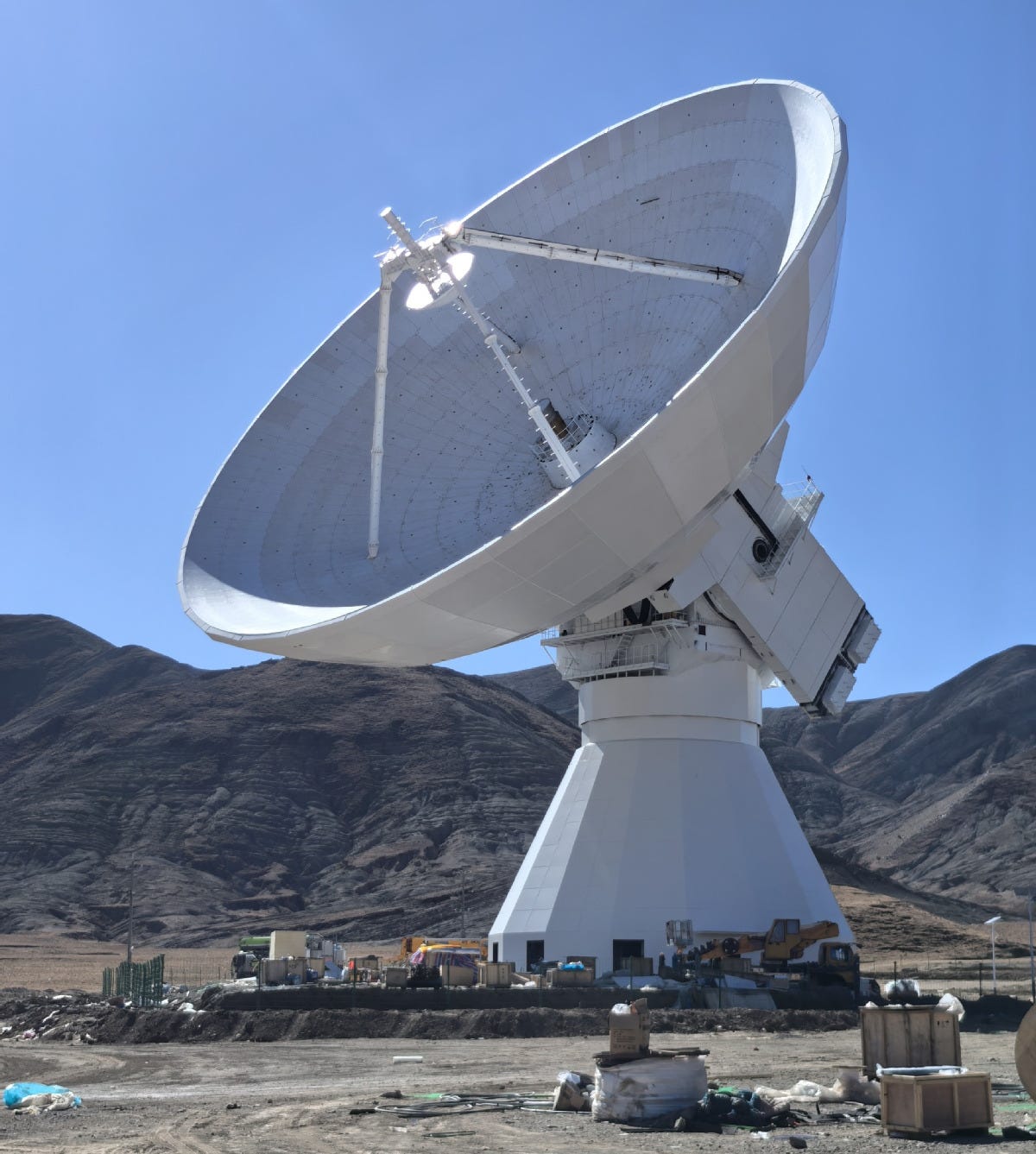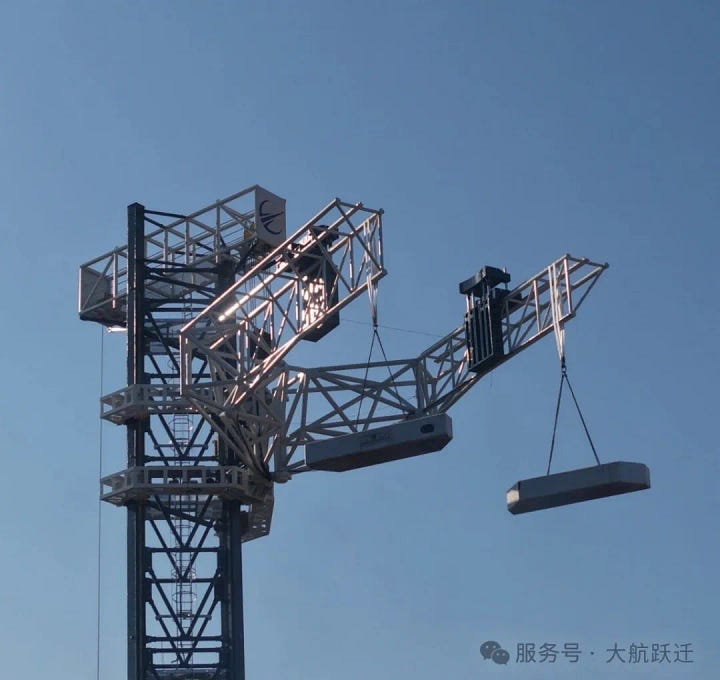First look at Long March 8A, possible new CNSA Admin, new Chang'e Moon samples approved
China is preparing for another year of space innovation and progress in the last week of 2024.
With 2025 quickly approaching, China’s space sector is preparing for another ambitious year of debuts, innovation, and milestone missions. As such recent news has had a brand new rocket spotted, recovery hardware undergoing testing, major amounts of funding raised, and the radio telescope network expanded. Sadly another key figure has recently passed away too.
This post is also releasing on New Year’s eve in Europe and the New Year in China, so happy New Year!
Long March 8A spotted ahead of debut
On December 29th the China Academy of Launch Vehicle Technology’s newest rocket, the Long March 8A, was spotted at the Wenchang Space Launch Site being transported between the launch vehicle assembly building at Launch Complex 201. Some testing of the launch vehicle is believed to have occurred too based on local airspace closures.
Back on December 9th hardware arrived in Hainan for the rocket along with reports stating that a debut mission would occur in January 2025. The debut flight of the rocket will provide the first flight of the liquid hydrogen and liquid oxygen burning YF-75H engines, ahead of their use on the Long March 10’s third-stage, as well as China’s second 5.2-meter diameter fairing.
The Long March 8A is largely based on the existing Long March 8 launch vehicle, including the first-stage and boosters. The vehicle has a redesigned second-stage, powered by improved YF-75H engines, and has been extended from 3 to 3.35 meters in diameter. Its upgraded second-stage has increased the payload capacity, with a low Earth orbit capability of 8,400 kilograms, up from 8,100 kilograms, and a 700-kilometer sun-synchronous orbit capacity of 7,000 kilograms, up from 5,000 kilograms.
Radio telescope network expanded

Announced on December 27th, two new 40-meter-diameter radio telescopes were made operational and added to China’s Very-Long-Baseline Interferometry network. With the new telescopes, this network has one control center in Shanghai (上海) and six stations in Shanghai, Urumqi (乌鲁木齐市), Kunming (昆明市), Changbai Mountain (长白山) and Shigatse (日喀则市).
The two new telescopes were built by the Shanghai Astronomical Observatory, part of the Chinese Academy of Sciences, in the Changbai Mountain area in Jilin Province and Shigatse in the Xizang Autonomous Region. These new telescopes will also expand the observable sky by twenty-five percent, and X-band resolution by eighteen percent, for the Very-Long-Baseline Interferometry network.
China’s Very-Long-Baseline Interferometry network allows multiple astronomical telescopes to observe a celestial body simultaneously, simulating the observation effect of a giant telescope equivalent to the maximum distance between telescopes. According to Shen Zhiqiang (沈志强), Director of the Shanghai Astronomical Observatory, this area is 3,800 kilometers.
This network has also been used to support all of the Chang’e Moon missions, the Tianwen-1 Mars mission, and the two Queqiao lunar communications satellites. The Tianwen-2 asteroid sample return mission will also be supported by the network next year.
Academician Xing Qiuhen passes away
Reporters from The Paper (澎湃新闻) were informed by the China Aerospace Science and Technology Corporation on December 29th that Academician Xing Qiuhen (邢球痕) had passed away that day due to illness at the age of 95 in Xi’an (西安市), Shaanxi Province.
Xing Qiuhen was born in Shengzhou, Zhejiang Province, in September 1930. He joined the Communist Party of China in December 1954 and graduated from the Artillery Engineering Department of the Military Engineering College of the Chinese People's Liberation Army in 1957. In 1958, he joined the Rocket Engine Research Laboratory of the Fifth Institute of the Ministry of National Defence.
Throughout his career, Xing held a variety of positions, including technician and team leader at the Fourth Laboratory of the First Branch of the Fifth Institute, team leader and deputy director of the Solid Rocket Engine Design Institute, and director of the research laboratory at the 41st Institute of the Fourth Institute of the Seventh Ministry of Machine Building. He later served as president of the Fourth Institute of the Ministry of Aerospace Industry, director of the Fourth Aerospace Institute's Science and Technology Committee, and consultant for the Science and Technology Committees of the China Aerospace Science and Technology Corporation and the China Aerospace Science and Industry Corporation, respectively. In 2003, he was elected to the Chinese Academy of Sciences.
Xing Qiuhen devoted his career to developing solid rocket propulsion technology in China. He handled the designing, manufacturing, and testing of solid rocket engines for various vital national strategic and tactical missile systems, overcoming numerous critical technological obstacles. His work helped advance several of the country's critical strategic and tactical models.
As a trailblazer in China's solid rocket technology, Xing played a pivotal role in making the idea of solid missiles a reality. His efforts significantly accelerated the growth of China's aerospace industry, reinforced its national defense equipment sector, and fostered a new generation of aerospace science and technology talent.
My words based on The Paper’s reporting, the China Aerospace Science and Technology Corporation’s blog post, and Xing Qiuhen’s Baidu page.
New batch of lunar samples approved
The China National Space Administration approved the latest batch of lunar sample research applications on December 28th. These applicants will be sent 8,550.4 milligrams of surface samples from the Chang’e 5 and Chang’e 6 missions.
Sixteen institutions will be receiving the samples and are the University of Hong Kong, the Macau University of Science and Technology, Wuhan University, Beihang University, the China University of Geosciences (Beijing), the China University of Geosciences (Wuhan), Beijing University of Aeronautics and Astronautics, Nanjing University, Northwestern University, Guangdong University of Technology, Donghua University of Science and Technology, Tsinghua University, University of Science and Technology of China, Institute of Geology and Geophysics (Chinese Academy of Sciences), the Chinese Academy of Sciences, and the National Space Science Center’s Chinese Academy of Geological Sciences.
Currently China has 3666.3 grams of lunar surface samples, Chang’e 5 collected 1,731 grams in 2020 while Chang’e 6 gathered 1,935.3 in 2024. Samples from the missions have been used to study the fields of lunar surface process, volcanic activity age, lunar evolution process, as well as mineral and volatile composition.
Cosmoleap conducts further recovery tower tests


Cosmoleap shared on December 30th that the company had completed another test with its prototype rocket recovery tower. This test had the tower’s arms opened and closed a few times followed by a lift of two large weights, the mass of which was not shared. The company’s blog post about the test stated:
“During the static test assessment process of the test tower, the data curves of the key structural measurement points were good and in line with the simulation prediction results. After system debugging, all functional mechanisms of the test tower were able to execute a series of actions in an orderly manner according to the predefined instructions, and the performance of the tower system was in line with expectations.”
If there are any problems with this translation please reach out and correct me.
A few weeks back Cosmoleap was conducting tests of the tower with a static pathfinder of its Leap (跃迁一号) launch vehicle. The debut flight of Leap is planned for 2025, possibly with recovery via the catch tower.
Leadership change at CNSA?

China’s State Administration of Science, Technology and Industry for National Defense (国家国防科技工业局), or SASTIND, announced on December 26th that Zhang Kejian (张克俭) had been removed as Secretary of the Party Leadership Group at SASTIND. Zhang Kejian also heads the China National Space Administration (CNSA), a role typically also held by the Party Secretary.
Replacing Zhang is Shan Zhongde (单忠德) from Gaomi (高密市), in Shandong Province. According to his AI for Good biography, Shan received a doctorate degree in mechanical engineering from Tsinghua University in 2002. He was elected as an Academician of the Chinese Academy of Engineering (CAE) in 2019. He previously served as the Director of Zhengzhou Research Institute of Mechanical Engineering, the Deputy General Manager of China Academy of Machinery Science and Technology Group Co., Ltd. (CAM), the President and Secretary of CPC Party Committee of Nanjing University of Aeronautics and Astronautics (NUAA) successively. He is currently the Vice Minister of the Ministry of Industry and Information Technology (MIIT) of the People’s Republic of China. Rather awkwardly for China-U.S. relations Shan was sanctioned by the first Trump administration.
It’s unknown if Zhang Kejian will also leave his role at CNSA, either being promoted elsewhere or for a corruption investigation. There are also rumors of the creation of a Chinese equivalent to the U.S. Federal Aviation Administration’s process for regulating commercial space launches.
Previous heads of CNSA have typically been promoted elsewhere with Tang Dengjie (唐登杰) being made Governor of Fujian Province, Xu Dazhe (许达哲) being promoted to Governor of Hunan Province, Ma Xingrui (马兴瑞) being made Party Secretary of the Shenzhen special economic zone, and Chen Qiufa (陈求发) promoted to Chairman of the Hunan Provincial Committee of the Chinese People's Political Consultative Conference.
Changguang Satellite performs 100-Gbps test
According to Xinhua on December 29th, Changguang Satellite Technology Co Ltd (长光卫星技术股份有限公司) has conducted a successful one hundred gigabits per second image transmission test. This test had one of the company’s Jilin-1 satellites transfer the image to teams on the ground.
To achieve this high-speed transfer the satellite has a laser communications terminal onboard and kept a stable connection to a ground station below. The connection between the satellite and the ground was described by Xinhua as being a coherent, ultra-long distance, high-sensitivity laser communication link.
These incredibly high-speed transfer speeds are believed to be needed for the ‘ultra-high-resolution’ Jilin-1 remote sensing satellites as each spacecraft will generate massive amounts of data each day. Higher transfer speeds will allow for increasingly larger amounts of data to be available sooner, assisting in areas such as disaster monitoring and emergency response.
To date, Changguang Satellite Technology has one hundred and thirty satellites in orbit for the Jilin-1 remote sensing constellation, allowing it to observe most of Earth roughly forty times a day.
Genesat raises 1 billion Yuan
Genesat (格思航天) announced on December 30th that the company had completed its Series A+ funding round and raised 1 billion Yuan, approximately 137 million United States Dollars (as of December 30th). The investors behind this funding round were China’s National Manufacturing Transformation and Upgrading Fund, China Development Bank Science and Technology Innovation, Guosheng Capital, SIMIC Capital, and Shanghai FTZ Fund. China’s National Upgrading Fund also recently invested 900 million Yuan, 123.3 million United States Dollars, in LandSpace.
The company did not state what the additional funding would be used for. However it is likely to expand satellite manufacturing facilities ahead of the company needing to produce hundreds of satellites per year, if not each month, in the near future.
According to Space News’ Andrew Jones, Genesat was established in 2022 by the Chinese Academy of Sciences Innovation Academy for Microsatellites and Shanghai Spacecom Satellite Technology, the operator of the Qianfan mega-constellation. Genesat is also the main manufacturer and developer of Qianfan’s satellites, with up to 15,000 satellites needed by the 2030s.




